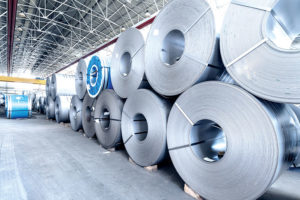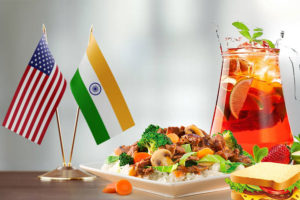India’s consumer goods exports: At an inflexion point?
India’s exports of consumer goods surged by over 60 times between 1990 and 2020. But India has a low share in high value-added products so far, with primary food pharma. textiles, small cars featuring in the list.
With policies like the PLI scheme that focus on sales performance and enhanced ease of doing business, India can aspire to replicate the Chinese success story in the sector.
- The world’s trade structure for consumer goods minutely increased in past three decades, as in 1990, world’s export share was 26.15% which experienced a tad rise of five percentage points, and import’s share by roughly two percentage points. In absolute terms it is observed that world’s exports of consumer goods burgeoned roughly by US$ 5.4 trillion.
- China, experienced a sharp rise in export share of consumer goods from 1990 to 2000, as its exports escalated from US$ 12.14 billion to US$ 221.77 billion, which is more than 18 times rise. But thereafter, China experienced a decline in its export share of consumer goods, from 54.71% in 2000, to 31.8% in 2018.
- From 2000 to 2010, India’s exports of consumer goods surged by US$ 70 billion, whereas for China, this figure remained US$ 490 billion, which was seven times. For India, within consumer goods, the biggest concentration of micro, small and medium enterprises (MSMEs) in the country is in the textile and clothing sector (17.30%), followed by food products (12.30%) and crop and animal production (10%).
- As per the revealed comparative advantage, India has an RCA greater than China, for consumer goods. The way China dominated the consumer goods exports from 1990 to 2010, India can aspire to perform similarly for next ten to fifteen years.

Photo by Anna Shvets from Pexels
During the turn of the twentieth century, the traditional agro-based economy started getting reallocated to the manufacturing and services sectors, and their shares in gross domestic product (GDP) and international trade proliferated drastically. It is said that the new trade theory proposed by Paul Krugman facilitated consumers globally to choose quality products at competitive prices. This happened because of technology, globalization and augmentation of suppliers for a range of products.
One of these product categories is consumer goods, which are defined as any products categorized in UNCTAD-SoP3, which is grouped by Stages of Processing (SoP). So as per UNCTAD, SoP-1 is categorized as raw materials, SoP-2 as Intermediate goods, SoP-3 as consumer goods and SoP-4 as capital goods. According to this same classification, there are 1,532 products at HS-Six digit.
From a layman’s perspective, consumer goods are any tangible commodities purchased to satisfy the current wants and perceived needs of a buyer. Common examples of consumer goods include food, clothing, footwear, home appliances, white electronic goods, etc. Growing awareness, easier access, and changing lifestyles are the key growth drivers for the consumer market in the current time period. However, India’s trade performance in this sector has not been as robust as it was in the case of the capital goods sector. In this column, we will analyse the transforming trade structure of consumer goods in India and globally.
Analysis
The global trade structure for consumer goods has not altered significantly over the past three decades. In 1990, the world’s export share was 26.15%, which experienced a small rise of five percentage points, and import share rose by roughly two percentage points. In absolute terms it is observed that world’s exports of consumer goods has grown roughly by US$ 5.4 trillion.
China experienced a sharp rise in export share of consumer goods from 1990 to 2000, as its exports escalated from US$ 12.14 billion to US$ 221.77 billion, growing by over 18 times. But thereafter, China experienced a decline in its export share of consumer goods, from 54.71% in 2000, to 31.8% in 2018. This decline was the resultant of increasing labour cost to manufacture these consumer goods, which was juxtaposed by a rise in domestic freight and transportation cost within China during that period. Chinese imports of consumer goods augmented in its share, representing 10.37% in 1990 and 15.14% in 2018. For Europe and Central Asia, the broad trade structure for consumer goods remained stable.
Table 1: Consumer goods trade snapshot in 1990
| Countries | Export (US$ billion) | Export product share (%) | Import (US$ billion) | Import product share (%) |
| China | 12.14 | 43.23 | 1.69 | 10.37 |
| India | 2.02 | 28.93 | 0.77 | 10.86 |
| United States | 44.72 | 17.96 | 103.68 | 33.49 |
| World | 352.44 | 26.15 | 409.44 | 29.71 |
| East Asia & Pacific | 80.90 | 28.6 | 52.96 | 20.21 |
| Europe & Central Asia | 169.93 | 32.08 | 185.15 | 33.65 |
| South Asia | 3.33 | 31.73 | 2.36 | 16.63 |
Source: WITS
Table 2: Consumer goods trade snapshot in 2000
| Countries | Exports (US$ billion) | Export product share (%) | Imports (US$ billion) | Import product share (%) |
| China | 221.77 | 54.71 | 25.27 | 11.1 |
| India | 15.97 | 34.6 | 5.81 | 10.6 |
| United States | 165.41 | 20.36 | 484.26 | 35.64 |
| World | 1,886.60 | 29.3 | 2,106.60 | 29.85 |
| East Asia & Pacific | 538.19 | 32.23 | 309.69 | 21.99 |
| Europe & Central Asia | 822.47 | 31.65 | 914.48 | 32.47 |
| South Asia | 30.32 | 44.98 | 11.23 | 13.91 |
Source: WITS
Table 3: Consumer goods trade snapshot in 2010
| Countries | Export (US$ billion) | Export product share (%) | Import (US$ billion) | Import product share (%) |
| China | 712.07 | 36.63 | 161.03 | 12.07 |
| India | 86.18 | 37.83 | 36.25 | 11.17 |
| United States | 302.88 | 24.36 | 769.70 | 37.27 |
| World | 4,529.66 | 29.88 | 5,183.81 | 30.78 |
| East Asia & Pacific | 1,382.37 | 29.77 | 897.99 | 21.81 |
| Europe & Central Asia | 2,019.30 | 34.91 | 2,311.45 | 35.74 |
| South Asia | 123.41 | 43.87 | 60.94 | 14.52 |
Source: WITS
Table 4: Consumer Good’s Trade Snapshot in 2018
| Countries | Export (US$ Billion) | Export Product Share (%) | Import (US$ Billion) | Import Product Share (%) |
| China | 875.98 | 31.84 | 291.58 | 15.14 |
| India | 121.02 | 42.5 | 46.60 | 10.92 |
| United States | 416.08 | 26.44 | 1,028.41 | 36.89 |
| World | 5,765.91 | 30.55 | 6,520.91 | 31.3 |
| East Asia & Pacific | 1,761.67 | 28.94 | 1,274.56 | 22.88 |
| Europe & Central Asia | 2,586.89 | 36.31 | 2,758.34 | 36.46 |
| South Asia | 189.80 | 51.1 | 87.52 | 14.8 |
Source: WITS
Indian scenario
India’s story of consumer goods trade is a little different as compared to China. A major increase in India’s exports of consumer goods was observed in the first decade of 21st century, relatively, and not in absolute terms. From 2000 to 2010, India’s exports of consumer goods surged by US$ 70 billion, whereas for China, they grew by US$ 490 billion, which was seven times.
For India, within consumer goods, the biggest concentration of micro, small and medium enterprises (MSMEs) in the country is in the textile and clothing sector (17.30%), followed by food products (12.30%) and crop and animal production (10%). From the exports point of view, India’s top consumer good exports do not include high value-added products so far, with primary food pharma. textiles, small cars featuring in the list. But with policies like the PLI scheme that focus on sales performance and enhanced ease of doing business, we may also compete within high value-added consumer goods globally.
Major reasons for the increase of India’s consumer goods exports from early 2000 till 2018 includes liberal FDI policies, gaining domestic competitiveness and making domestic manufacturing platforms more robust, especially for electronic products and integration of ecommerce. Recently, it has been seen that many firms are investing in India to create a manufacturing base of various consumer products such as mobile phones and automobiles, whose value addition component is among the highest within consumer goods. Simultaneously, they are also investing in the supporting ecosystem. For example, One of the recent foreign investments is by three private equity funds Investcorp, Norwest Venture Partners and Gaja Capital, who cumulatively invested US$ 110 million to boost supply chain infrastructure for e-commerce sector. This is expected to improve India’s GVC participation as well.
Upcoming Policies
Indian government came up with incentive policies to promote consumer goods production such as Production-Linked Incentive (PLI) scheme in 10 key sectors (including electronics and white goods) to boost India’s manufacturing capabilities, exports and promote the ‘Atmanirbhar Bharat’ initiative. This year’s Union Budget promised a healthy allocation of capital in building infrastructure and transportation, making the consumer goods sector more competitive.
Exports of mobile phones, for instance, are expected to have reached a record of US$ 1.5 billion in 2020 according to TechArc, of which 98% are expected to be smartphones. As per the revealed comparative advantage, India has an RCA greater than China, for consumer goods. The latter dominated the consumer good segment between 1990 and 2010. Through targeted policy interventions and the strength of private enterprise, India should aspire to perform similarly for the next ten to fifteen years.













Leave a comment